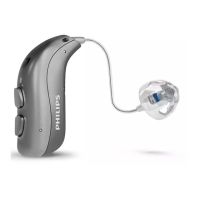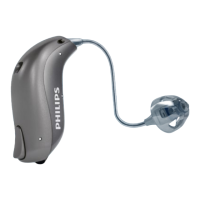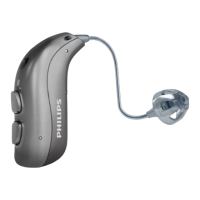
Do you have a question about the Philips HearLink miniRITE T and is the answer not in the manual?
| Brand | Philips |
|---|---|
| Model | HearLink miniRITE T |
| Category | Hearing Aid |
| Language | English |
Advises medical consultation for individuals under 18 before using the hearing aid.
Instructions for dispensers on screening prospective hearing aid users for specific ear conditions.
Caution regarding fitting hearing aids with maximum output exceeding 132 dB SPL to prevent hearing impairment.
Instructions on reporting device-related injuries, malfunctions, or other adverse events to the FDA.
Potential risks associated with Tinnitus SoundSupport, including worsening tinnitus or hearing thresholds.
Essential safety information for correct usage and handling of hearing aids.
Warnings about choking hazards from small parts and risks associated with batteries, including ingestion.
Advice on protecting hearing aids from extreme heat, microwave drying, and chemical damage.
Information on potential interference from RF communications equipment and how to mitigate it.
Details the hearing aid models covered by this booklet and lists available speakers.
Lists standard and customized speaker options and earpiece types, including dome sizes.
Diagram and labels identifying the main components of the hearing aid, speaker, and earpiece.
Information on the time required to fully charge the hearing aid and the charging process.
Guidance on distinguishing between left and right hearing aids using color indicators.
Steps for turning the hearing aids on and off, including using the charger and push-button.
Instructions on automatic ON/OFF functionality when using the charger for MNR T R models.
Steps for manually turning the hearing aid ON/OFF using the push-button for MNR T R models.
Method for turning MNR T models ON/OFF by operating the battery drawer.
Explanation of audible tones and LED indicators that signal a low battery level.
Instructions for safely removing and inserting size 312 disposable batteries into the hearing aid.
Detailed steps for correctly fitting the hearing aid into the ear for optimal performance.
Guidance on cleaning the hearing aid and its accessories using the provided MultiTool.
Instructions for cleaning the hearing aid, focusing on microphone openings with the MultiTool brush.
Instructions for removing and attaching standard earpieces, including replacement frequency for Grip Tips.
Details about the white wax filter, its purpose, and when to replace it.
Step-by-step guide for replacing the ProWax miniFit wax filter using the provided tool.
Instructions for cleaning customized earpieces, including managing their wax filter.
Step-by-step guide for replacing ProWax filters in customized earpieces.
Instructions on using the push-button to increase or decrease the hearing aid volume.
Guidance on changing hearing aid programs using the push-button and understanding program tones.
Recommendations for storing hearing aids, including long-term storage and battery care.
Instructions for enabling and disabling Flight Mode, which turns off Bluetooth connectivity.
Methods for muting and unmuting hearing aids using companion apps or the push-button.
Information on connecting hearing aids to Apple devices for direct streaming and control via HearLink 2.
Details on connecting hearing aids to Android devices for direct streaming using ASHA support.
Guidance on pairing hearing aids with compatible mobile devices and checking compatibility lists.
Instructions for answering, rejecting, or ending phone calls using the hearing aid push-buttons.
Overview of accessories like AudioClip, TV Adapter, and Remote Control that enhance hearing aid functionality.
Information about the HearLink 2 application for wireless access, control, and remote updates of hearing aids.
Explanation of how Telecoil helps users hear better in environments with teleloop systems.
Describes Tinnitus SoundSupport as a tool for temporary relief of tinnitus symptoms.
Instructions and advice for users of Tinnitus SoundSupport, emphasizing professional follow-up care.
Information on programming Tinnitus SoundSupport, selecting sound options, and adjusting volume controls.
Guidance on recommended daily usage limits for Tinnitus SoundSupport to prevent hearing damage.
Table detailing common symptoms, possible causes, and solutions for hearing aid malfunctions.
Specific troubleshooting steps for issues related to the hearing aid charger and LED indicators.
Details on the hearing aid's IP68 rating for protection against water and dust ingress.
Specifications for ideal temperature, humidity, and atmospheric pressure for operating and charging the hearing aid.
Information on the hearing aid's radio transceiver technologies and compliance with international standards.
Details regarding compliance with FCC RF exposure limits for portable use.
Information regarding potential compatibility issues and standards for hearing aid and cell phone interaction.
Data on the maximum output sound pressure level of the hearing aids across different frequencies.
Graphs illustrating the frequency response of the hearing aid for acoustic and magnetic inputs.
Graphs showing the input-output relationship, indicating gain levels at different input signal strengths.











